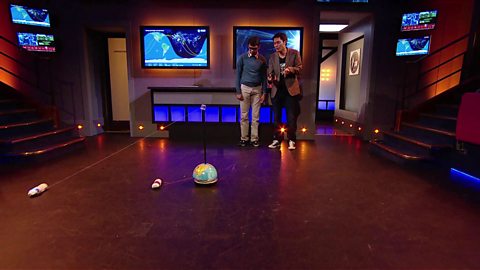Dr Kevin Fong uses two children from the audience to help to demonstrate Newton’s suggestion that if you can throw a projectile fast enough and far enough, it will end up travelling around the Earth in orbit.
This is known as Newton's Third Law.
This theory was recorded in his famous publication ‘Principia’, and the curator of the Royal Institute's archives, Charlotte New, shows the audience a second edition of one of the volumes of it.
Kevin then demonstrates Newton's Third Law using fire extinguishers to propel himself on a trolley and explains how this is linked to rocket propulsion.
This clip is from the Royal Institution Christmas Lectures 2015.
Teacher Notes
This clip could be used to introduce the topic of space travel and the effect of gravity and other forces.
Newton’s Third Law and its application to rocket propulsion could be demonstrated by allowing students to blow up balloons and release them, or by using a water powered rocket.
Curriculum Notes
This clip will be relevant for teaching GCSE Physics.
This topic appears in OCR, Edexcel, AQA, WJEC KS4/GCSE in England and Wales, CCEA GCSE in Northern Ireland and SQA National 4/5 in Scotland.
More from the Royal Institution Christmas Lectures 2015
Using Earth’s rotation to launch a rocket. video
Dr Kevin Fong demonstrates how a space rocket’s launch direction affects its success in reaching orbit.

How the vacuum of space affects the human body. video
Dr Kevin Fong does a demonstration to show the lethal effects of a vacuum on the human body.

Resonant Frequency. video
Dr Kevin Fong explains how sound vibrations could pose a real threat astronauts and rockets in space.

Orbital Rendezvous. video
Dr Kevin Fong demonstrates how and why it's so hard for a spacecraft to catch up with the International Space Station.

What does gas weigh? video
A demonstration that carbon dioxide can be poured because it is denser than air.

Why are bones weaker in orbit? video
Kevin Fong explains how micro-gravity can weaken bones. Models are used to show that bones are strong but light, and how low gravity weakens them.

How micro-gravity disorientates us. video
A demonstration of how dizziness occurs during motion sickness or micro-gravity.

The danger of orbital debris. video
Dr Kevin Fong and NASA astronaut Dan Tani explain the danger of space debris.

Demonstrating heat shield material. video
Dr Kevin Fong explains that space capsules heat up due to pressure not friction. He demonstrates a heat shield’s low thermal conductivity.

Why Earth rock is found on the Moon. video
Dr Kevin Fong demonstrates how debris from meteorites hitting Earth threw Earth rock as far as the Moon, leaving clues there about Earth’s geological history.

Demonstrating radiation detectors. video
Dr Kevin Fong shows how a Geiger-Muller tube can detect ionising radiation but not the type of radiation, and how detectors on the International Space Station can.

How Earth protects us from radiation. video
Dr Kevin Fong discusses the dangers to astronauts of solar radiation, and how we’re protected from it by Earth’s atmosphere and magnetic field.

Why tardigrades can survive in orbit. video
Dr Kevin Fong explains why tardigrades are so resilient when exposed to ionising radiation lethal to most other organisms.

How to recycle urine in space. video
Dr Kevin Fong demonstrates a urine recycling system that works using osmosis, concluding by drinking the liquid that is produced.

Ã˝